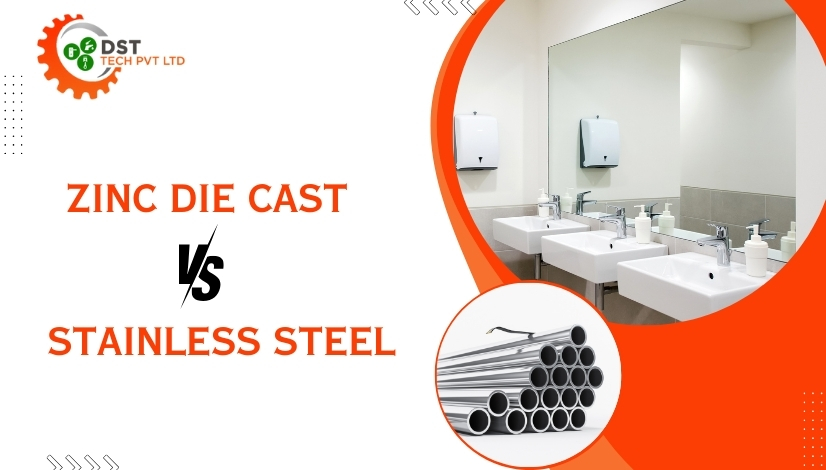When it comes to manufacturing high-quality components, choosing the right material is essential. Two commonly used materials in industrial and consumer product manufacturing are Zinc die-cast and stainless steel. Each material has its strengths, but the deciding factor often comes down to precision and design flexibility. Let’s explore the advantages of both materials in these areas and determine which one offers better results for manufacturers.
Precision in Manufacturing: Zinc Die Cast vs Stainless Steel
Zinc Die Casting
Zinc die casting is known for its exceptional precision. The process allows manufacturers to create complex geometries and intricate designs with tight tolerances, all while maintaining consistency across large production volumes. One of the key advantages of Zinc die casting is its ability to produce near-net-shape components, reducing the need for further machining or finishing. This makes it ideal for applications where precision is critical, such as in sanitary ware, automotive parts, and architectural hardware.
Stainless Steel
Stainless steel, while extremely durable and corrosion-resistant, doesn’t offer the same level of precision in manufacturing as Zinc die casting. Components made from stainless steel often require additional machining and finishing to achieve the desired level of accuracy, which can increase production time and cost. Stainless steel’s toughness can sometimes pose challenges in achieving highly detailed or intricate designs, especially when compared to the ease and precision of Zinc die casting.
Design Flexibility: Zinc Die Cast vs Stainless Steel
Zinc Die Casting
One of the standout features of Zinc die casting is its versatility in design. The casting process enables manufacturers to create complex shapes with fine details that would be difficult or impossible to achieve with other materials. Zinc die-cast is particularly suited for producing parts with thin walls, intricate patterns, or tight radii, offering unparalleled design freedom. Components such as faucet handles, door knobs, and automotive parts benefit from the flexibility that Zinc die-cast provides.
Stainless Steel
Stainless steel is renowned for its strength and durability, but it can be less flexible when it comes to design. Creating highly intricate or detailed designs out of stainless steel often requires additional processes like forging or extensive machining, which can be costly and time-consuming. While stainless steel is perfect for heavy-duty applications that demand high strength and corrosion resistance, it may fall short when complex design and fine detailing are required.
Weight and Material Properties
Zinc Die Casting
Zinc is a relatively lightweight material compared to stainless steel. This characteristic makes it ideal for applications where weight is a consideration, such as in automotive parts or architectural hardware. Additionally, Zinc offers excellent dimensional stability, meaning that parts retain their shape and precision over time, even in demanding conditions.
Stainless Steel
Stainless steel is much heavier than Zinc and offers superior strength, but this strength comes at the cost of design flexibility and ease of production. While it is extremely durable and resistant to corrosion, the added weight may not be ideal for all applications, especially those requiring lighter components.
Cost Efficiency
Zinc Die Casting
Zinc die-cast generally provides a more cost-effective solution for manufacturers due to its ability to produce parts with minimal post-processing. The near-net-shape casting capability reduces waste and machining requirements, making Zinc die casting a more economical option for large-scale production runs. Additionally, the reusability of Zinc in die casting adds to its cost efficiency, as manufacturers can recycle leftover material without loss of quality.
Stainless Steel
While stainless steel offers durability and longevity, it is often more expensive to process and finish compared to Zinc die-cast. The need for additional machining, combined with its heavier weight and higher raw material cost, can drive up production expenses, particularly for intricate or precision-dependent designs.
Conclusion: Why Zinc Die Casting Is the Better Choice for Precision and Flexibility
When comparing Zinc die-cast and stainless steel, it’s clear that Zinc die-cast offers superior precision and design flexibility, especially for industries like sanitary/bathware, automotive parts, and architectural & kitchen hardware. Zinc die casting provides manufacturers with the ability to create detailed, lightweight components with minimal post-processing, making it the ideal choice for high-precision, high-volume production.
If you’re looking for a manufacturing partner that excels in precision Zinc die-cast, DST Tech is here to help. With expertise across diverse sectors, including Sanitary/Bathware, Automotive Parts, and Architectural & Kitchen Hardware, DST Tech offers cutting-edge solutions that combine precision with cost-efficiency. Contact DST Tech today to learn more about how our Zinc casting services can enhance the quality and efficiency of your next project.

